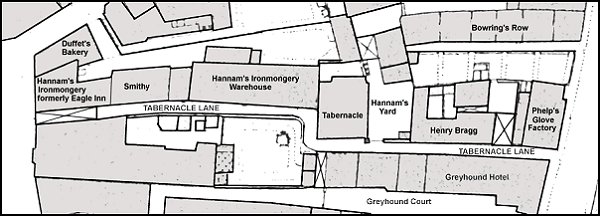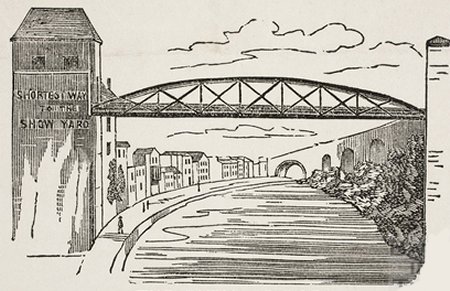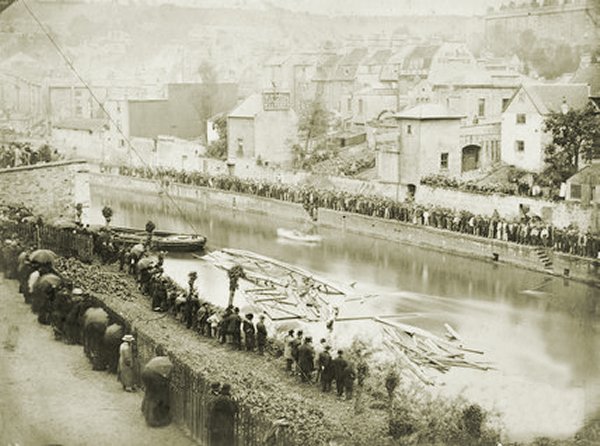Yeovil People
James Brown
Accident prone Blacksmith of Tabernacle Lane
James Brown, known as Jim, was born in Trent (just northeast of Yeovil and, at this time, in Somerset) in 1850, the son of Job Brown (1822-1885) and Elizabeth née Hooker (1821-1895), originally from Heytesbury, Wiltshire. In the 1851 census Job and Elizabeth, both aged 29, were living in Trent with their three children Hannah (b 1842), Eliza (b 1848) and one-year old James. Job gave his occupation as a carter. In the 1861 census the family were listed at Sherborne Road, Trent. By this time Hannah had left home and Eliza had died, but James now had four new siblings; Tom (b 1852), Eliza (b 1854), Job (b 1857) and George (b 1859). By 1871 James had two more siblings; Charles (b 1862) and Elizabeth (b 1867). Job gave his occupation as a labourer, as did his sons Tom and George. James, however, was working as a smith.
On 31 March1872 Jim married Mary Ann Winsor (1850-1898) at St John's church, Yeovil. They were to have seven children; William Henry (b 1873), Herbert George (b 1876), Anne Louisa (b 1879), Frederick James (b 1880), Rose Kate (b 1882), Frank Roland (b 1886) and Arthur (b 1889).
At some time during the early 1870s Jim took over the smithy in Tabernacle Lane from John Higdon. Jim and Mary lived at the smithy and started their family there.
On 6 June 1877 Jim and his younger brother Job (or it may possibly have been his father Job) went on an excursion train from Weymouth, via Yeovil, to visit the Bath & West Centenary Show being held at Bath. In order to reach the site of the show the day-trippers had to cross the Halfpenny Bridge at Widcombe, Bath, but tragedy struck as the wooden bridge collapsed carrying people across the river.
Widcombe Footbridge, which opened in 1863 and gave residents, on the south side of the river, easy access to the railway station. This bridge was known as the Ha'penny Bridge as it was a toll bridge with the toll-house at the Widcombe end. On 6 June 1877, hundreds of people, who had just arrived by train, converged at the bridge to cross to the show ground of the Bath and West of England Agriculture Society, which was celebrating its centenary. As there was only one toll-collector, progress across the bridge was slow. It was estimated that there were between two and three hundred people on the bridge when it started to collapse. Fortunately, many were able to get off the bridge before it fell into the water.
There are varying accounts of the number of people killed. Harper's New Monthly Magazine, claimed that "Twenty persons were killed, and a much larger number injured." Some sources claim as few as eight people died. However, twelve seems to be the generally accepted number of casualties. In fact the Coroner's Inquest was held into the deaths of eight people. In any event, some fifty were injured, including Jim and Job.
In its edition of 7 June 1877 The Times reported "... James Brown, South-street Yeovil, injury to spine and fractured leg (not expected to live); Job Brown, of Trent, Somerset, fractured leg and injury to back..." Jim was eventually discharged from the Bath Royal United Hospital on Thursday 19 July 1877.
After recovering from the disaster, Jim returned to work at the smithy in Tabernacle Lane and in the 1881 census he and Mary were listed living there with the first four of their children. Jim gave his occupation as 'Blacksmith employing 1 man & a boy'.
In his spare time, Jim was a member of the Yeovil Fire Brigade which, at this time, was essentially a volunteer organisation. He eventually rose through the ranks to become Lieutenant under Captain Robert Damon. In the spring of 1890, the Yeovil Fire Brigade attended the Paris Exhibition and, because Captain Damon was unable to attend, the Brigade was commanded by Jim during the visit. The purpose of the visit was to display the Brigade's drill before thousands of people at the exhibition - for which they were awarded a gold medal. On their return, the members of the Yeovil Fire Brigade were entertained at a complimentary dinner at the Three Choughs Hotel hosted by the Mayor, Herbert Southcombe, and a number of other worthies. The members of the Brigade were each presented with a replica of the medal won at the exhibition and there followed many toasts and speeches, including a short speech given by Jim. The Mayor, in his speech reported in the Western Gazette, said that he had "invited the members of the Yeovil Fire Brigade to that representative assembly as a mark of his own feeling, which he was sure was shared by other people, that the services which the Brigade rendered from time to time were of great value. They were subject to all sorts of winds and weathers, and their duties were various and often very heavy; and the inhabitants of the town were very much indebted to them for the services which they voluntarily rendered."
After being feted and praised so lavishly, within three weeks disaster was to befall Jim. The following report is taken from the Western Gazette's edition of 6 June 1890.
"Yesterday (Thursday) morning a shocking fatal accident occurred at the level crossing adjoining the platforms at the Sherborne railway station. About twenty minutes after eleven o'clock, a train was standing at the station and Mr James Brown, blacksmith, of Yeovil, was seen to walk up the platform and greet the driver (Mr Sam Dyer, also of Yeovil, whom the deceased knew) with a cheery "Good Morning", and enter into a conversation , which was continued whilst the train remained in the station. On the train steaming off, he waved a 'goodbye' to the driver, and as soon as the train passed proceeded to cross the metals to the swing-gate with a view to entering the New Road. The 11.19 down was now some time overdue, and deceased had scarcely left the up-platform before his dead body lay beside the line. The up-train had obscured from his view the coming down, and on his placing his foot upon the down four-foot way the right buffer of the engine caught his left side, knocking him against the locked gate with tremendous force. The body at once rebounded, the head of the unfortunate man coming in contact with some other portion of the train. The head was shattered, and the right arm and ribs were also broken. As the body lay exposed it presented a sickening spectacle, but Mr Somerfield, the station master, caused it to be quickly covered, and on the police being acquainted with the shocking affair, the body was removed to the Woolmington Hotel to await an inquest.
The accident was witnessed by a number of persons, who naturally felt a thrill of horror. No blame attaches to the railway employees, the passage from the platforms over the crossing being being at all times strictly prohibited.
The news of the sad event created profound feelings of regret in Yeovil, the deceased being universally respected. He left his home by train for Sherborne on business in the morning, and shortly after his arrival on the platform he thus lost his life. Mr Maunder, superintendent at the Yeovil Station, very kindly undertook the painful task of breaking the distressing news to the bereaved wife and family of the deceased, who are naturally prostrate with grief. The deceased was Lieutenant of the Yeovil Fire brigade, and for his proficiency won a gold medal at the fire brigade competition at the Paris Exhibition. He leaves a family of seven children.
From a statement made by the driver of the train by which Brown was killed, it would appear that deceased was observed by him to pass round the rear of the up train, and the whistle of his train was at once loudly blown to warn Brown of the danger. Deceased looked up, and would seem to have seen the train coming, but rushed across the line, with the sad result already recorded."
At the inquest George Phillips of Yeovil, a solicitor's clerk, said he had been talking with Jim from Yeovil to Sherborne on the morning of the accident. Jim left the train and was walking up the platform when George called to him "Jim, that's not the way out!" to which he replied "I am going that way" (pointing towards Sherborne Castle).
The Western Gazette reported "The funeral of deceased took place on Monday June 9th. A large number of shopkeepers and private residents showed their respect for the deceased by partially drawing their blinds or erecting shutters. In streets en route to the cemetery a large number of people were present and at the cemetery there was a very large assemblage to witness the obsequies... The funeral was attended by members of the Yeovil Fire Brigade, under Captain Damon, and several of the members of the local Court of Foresters, of which Order deceased was a member." Amongst the local tradesmen and friends present were Edmund Damon, Charles Hook, Levi Beer, James Moffatt, Samuel Cridland, and Henry Jesty.
Jim, Mary and their family moved just around the corner to 63 South Street (almost next door to South Street School), certainly by January 1889 when their son Arthur was born there. Jim's younger brother George moved into the accommodation over the blacksmith's forge with his family and in the 1891 census was listed living there with his wife Beatrice and their three young children. After Jim's death at the age of 40, Mary was recorded living at 63 South Street and her occupation was listed as a Blacksmith (she owned the smithy although clearly didn't work in it) and her and Jim's two eldest sons, William and George, were also recorded as blacksmiths.
Mary died at 38 Orchard Street, Yeovil, on 8 July 1898. She was aged 48.
MAP

This map is based on the 1886 Ordnance Survey, but rotated 90° with the Borough at extreme left and South Street at extreme right. The smithy is located towards the northern end of Tabernacle Lane.
gallery

This sketch of Widcombe Bridge appeared in several newspapers after the fatal disaster.

A dramatic sketch of the disaster that appeared in the Illustrated London News' edition of 16 June 1877.

The front page of the Illustrated London News' edition of 16 June 1877 showing the scene of the disaster.

A contemporary photograph showing the scene of the disaster, almost identical to the sketch on the front page of the Illustrated London News above.

Another contemporary photograph showing the scene from a little distance away.